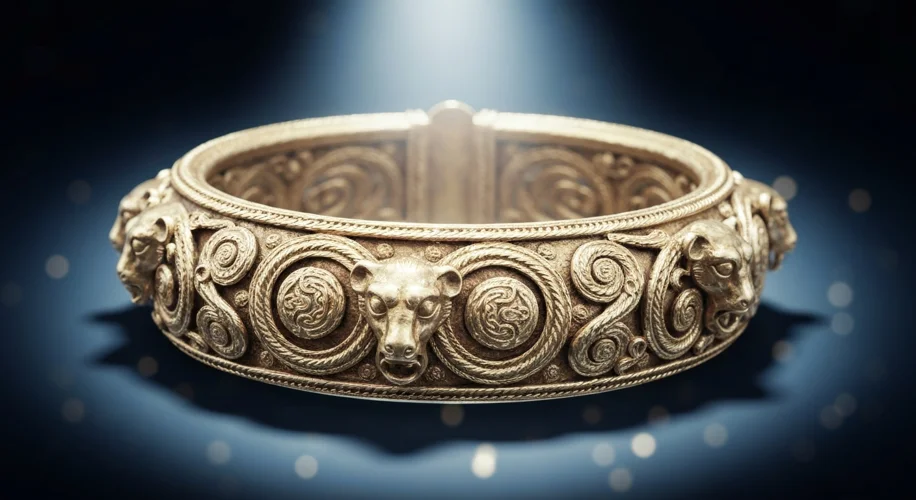Imagine a world where the glint of gold wasn’t just a sign of wealth, but a testament to unparalleled skill. Where iron wasn’t merely a tool of war, but an art form. This was the world of the Celts, a people whose mastery of metalworking left an indelible mark on ancient Europe, a legacy whispered in the intricate designs of their jewelry and the formidable edge of their weaponry.
The Celts, a diverse group of tribes who spread across Europe from roughly 800 BCE to the 1st century CE, were far from the simple, uncultured “barbarians” often depicted in later Roman accounts. Their societies were rich with tradition, complex social structures, and a deep connection to the spiritual world. This cultural depth found a powerful expression through their most prized material: metal.

From the shimmering amber hues of gold to the dark, utilitarian strength of iron, Celtic smiths transformed raw ore into objects of breathtaking beauty and formidable function. Their understanding of metallurgy was centuries ahead of its time. They didn’t just shape metal; they understood its very essence, coaxing it into forms that reflected their worldview.
Gold: The Metal of the Gods and Kings
Gold held a particularly sacred status among the Celts. It was associated with the sun, divinity, and the elite. The sheer quantity and quality of gold artifacts unearthed from Celtic sites speak volumes about their mining and refining capabilities. Think of the magnificent torcs – rigid neck rings, often elaborately twisted and decorated – that adorned the powerful men and women of Celtic society. These weren’t crude adornments; they were masterpieces of goldsmithing, often featuring intricate swirling patterns, zoomorphic (animal-shaped) designs, and geometric motifs that flowed with an almost organic grace.
The “Torque of Mšecké Žehrovice,” a stunning example of Celtic goldwork from Bohemia (modern-day Czech Republic), is a testament to this artistry. Discovered in 1877, this 2,000-year-old torc showcases incredibly fine granulation and repoussé work, a technique of hammering metal from the reverse side to create a design in relief. It’s a piece that would grace any modern museum with its exquisite beauty and masterful craftsmanship.
Beyond torcs, the Celts fashioned exquisite armlets, bracelets, brooches, and even delicate filigree earrings. These weren’t merely decorative; they were symbols of status, power, and identity, often exchanged as gifts to cement alliances or to honor heroes. The artistry involved in creating these pieces suggests specialized workshops and a sophisticated understanding of annealing (heating and cooling metal to make it workable) and soldering.
Iron: The Edge of Power and Innovation
While gold captivated with its beauty, iron defined the Celtic age with its strength. The Celts were among the first to widely adopt and master ironworking in Europe. Their development of iron swords, spearheads, and chariot fittings revolutionized warfare and daily life. Celtic iron swords, in particular, were renowned for their sharpness and durability. Unlike earlier bronze weapons, iron could be forged into a harder, keener edge that held up better in combat.
One of the most striking aspects of Celtic ironwork was their ability to produce patterned or “Damascus-style” blades, achieved by twisting and forging together rods of iron and steel. This complex process not only created beautiful, wavy patterns on the blade but also enhanced its strength and flexibility. Imagine the glint of such a blade in the sun, wielded by a warrior whose very presence commanded respect.
The “La Tène” style, named after a Swiss archaeological site, became the hallmark of Celtic art from the 4th century BCE onwards. This style is characterized by its curvilinear designs, often incorporating stylized animal forms, abstract patterns, and a dynamic sense of movement. This artistic sensibility wasn’t confined to gold; it permeated their ironwork, transforming even the most utilitarian objects into works of art. Axe heads, shield bosses, and even simple tools often bore intricate carvings or decorative elements that spoke of a culture that valued beauty in all aspects of life.
The Cultural Significance
For the Celts, metal objects were more than just possessions; they were imbued with spiritual significance. Gold was often offered to deities, deposited in bogs, or buried with the dead, connecting the earthly realm with the divine. Iron, the metal of the forge, was associated with strength, protection, and the power of transformation. The smith himself was often a revered figure, sometimes seen as possessing almost magical abilities due to his mastery over fire and metal.
These metal artifacts also played a crucial role in social cohesion and power structures. The distribution of finely crafted metal goods reinforced social hierarchies, rewarded loyalty, and served as tangible evidence of a leader’s wealth and influence. The ability to produce and control these valuable resources was a key aspect of Celtic political and economic power.
While the Roman conquest eventually absorbed and transformed many Celtic cultures, the legacy of their metalworking skills endured. The intricate patterns and sophisticated techniques influenced subsequent European art and metallurgy. The next time you see a piece of ancient Celtic jewelry or read about their formidable warriors, remember the hands that shaped the metal, the minds that envisioned the designs, and the vibrant culture that breathed life into these enduring creations.

